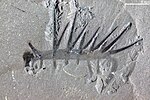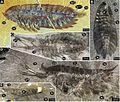The Burgess Shale is a fossil-bearing deposit exposed in the Canadian Rockies of British Columbia, Canada. It is famous for the exceptional preservation...
23 KB (2,509 words) - 16:01, 20 June 2024
a list of the biota of the Burgess Shale, a Cambrian lagerstätte located in Yoho National Park in Canada. The Burgess Shale is a fossil-bearing deposit...
78 KB (1,489 words) - 19:05, 16 September 2024
Anomalocaris (category Burgess Shale fossils)
(particularly the Burgess Shale) of British Columbia, Canada. The other named species A. daleyae is known from the somewhat older Emu Bay Shale of Australia...
44 KB (4,840 words) - 08:32, 5 November 2024
character to that of the Burgess Shale. While many are also preserved in a similar fashion to the Burgess Shale, the term "Burgess Shale-type fauna" covers...
20 KB (2,081 words) - 20:27, 11 July 2024
The fossils of the Burgess Shale, like the Burgess Shale itself, are fossils that formed around 505 million years ago in the mid-Cambrian period. They...
94 KB (9,317 words) - 15:34, 4 October 2024
; Caron, J.-B. (14 August 2019). "A new hurdiid radiodont from the Burgess Shale evinces the exploitation of Cambrian infaunal food sources". Proceedings...
96 KB (7,512 words) - 17:20, 12 November 2024
Cambrian explosion (section Burgess Shale type faunas)
satisfactory answer. American paleontologist Charles Walcott, who studied the Burgess Shale fauna, proposed that an interval of time, the "Lipalian", was not represented...
134 KB (15,441 words) - 23:08, 8 November 2024
Charles Doolittle Walcott (section Burgess shale)
well-preserved fossils, including some of the oldest soft-part imprints, in the Burgess Shale of British Columbia, Canada. Charles Doolittle Walcott was born on March...
25 KB (2,319 words) - 04:34, 13 November 2024
Field, British Columbia (section Burgess Shale)
42 years. CPR track workers in Field discovered the fossils of the Burgess Shale. Commonly called by the workers "the stone bugs", the first fossils...
8 KB (372 words) - 03:14, 10 September 2023
The Burgess Shale of British Columbia is famous for its exceptional preservation of mid-Cambrian organisms. Around 69 other sites have been discovered...
40 KB (4,584 words) - 02:50, 23 June 2024
Marrella (category Burgess Shale fossils)
North America and Asia. It is the most common animal represented in the Burgess Shale of British Columbia, Canada, with tens of thousands of specimens collected...
15 KB (1,502 words) - 23:45, 10 February 2024
Hallucigenia (category Burgess Shale fossils)
Hallucigenia is a genus of lobopodian known from Cambrian aged fossils in Burgess Shale-type deposits in Canada and China, and from isolated spines around the...
20 KB (1,866 words) - 14:37, 4 November 2024
Simon Conway Morris (section Burgess Shale)
biologist, and astrobiologist known for his study of the fossils of the Burgess Shale and the Cambrian explosion. The results of these discoveries were celebrated...
16 KB (1,465 words) - 21:36, 30 October 2024
and sponge faunas of Guizhou and Anhui. Along with the Burgess Shale, the Maotianshan Shales are remarked as "our best window into the Cambrian 'explosion'"...
31 KB (3,059 words) - 16:28, 12 June 2024
phosphatizing microbes. Soft-tissue fossils, such as those found in the Burgess Shale, are rare. In some cases their internal organs are replicated in phosphate...
9 KB (962 words) - 11:21, 27 September 2023
preserved fossil material. Part of the same stratigraphic unit as the Burgess Shale deposit, many non-mineralized parts (such as anomalocarid claws, sponges...
4 KB (476 words) - 06:09, 23 November 2023
Anomalocaris) and true arthropods. Re-examination in the 1970s of the Burgess Shale fossils from about 505 million years ago identified many arthropods...
131 KB (12,547 words) - 17:17, 13 November 2024
fieldensis Walcott, a mandibulate arthropod from the middle Cambrian Burgess Shale". Royal Society Open Science. 5 (6): 172206. Bibcode:2018RSOS....572206V...
177 KB (9,326 words) - 02:16, 2 November 2024
Sirius Passet, the Sinsk Algal Lens, the Maotianshan Shales, the Emu Bay Shale, and the Burgess Shale. The United States Federal Geographic Data Committee...
89 KB (9,329 words) - 20:21, 11 November 2024
Pikaia (category Burgess Shale animals)
an extinct, primitive chordate animal known from the Middle Cambrian Burgess Shale of British Columbia. Described in 1911 by Charles Doolittle Walcott...
50 KB (5,785 words) - 00:28, 29 October 2024
Opabinia (category Burgess Shale fossils)
regalis is an extinct, stem group arthropod found in the Middle Cambrian Burgess Shale Lagerstätte (505 million years ago) of British Columbia. Opabinia was...
44 KB (4,825 words) - 22:42, 16 August 2024
Ottoia (category Burgess Shale fossils)
spurious grounds, the only clear Ottoia macrofossils come from the Burgess Shale of British Columbia, which was deposited 508 million years ago. Microfossils...
11 KB (1,194 words) - 17:11, 4 June 2024
The Burgess Shale, a series of fossil beds in the Canadian Rockies, was first noticed in 1886 by Richard McConnell of the Geological Survey of Canada...
19 KB (2,589 words) - 17:00, 1 February 2024
Leanchoilia (category Burgess Shale fossils)
Leanchoilia is a megacheiran arthropod known from Cambrian deposits of the Burgess Shale in Canada and the Chengjiang biota of China. L. superlata was about...
7 KB (481 words) - 16:11, 21 June 2024
Cambrian chordates (category Burgess Shale fossils)
chordate known is Pikaia gracilens, a lancelet-like animal from the Burgess Shale in British Columbia, Canada. The discoverer, Charles Doolittle Walcott...
24 KB (2,720 words) - 18:41, 26 October 2024
arthropod. The Geological Survey of Canada initiated a revision of Burgess Shale fossils in 1966, overseen by Cambridge University paleontologist Harry...
95 KB (7,592 words) - 22:58, 13 November 2024
Oikozetetes is known only from two types of cap-shaped shell found in the Burgess Shale and dated to about 505 million years ago. The two types are thought...
63 KB (6,415 words) - 14:52, 14 July 2024
Odaraia (category Burgess Shale fossils)
which reach 15 centimetres (5.9 in) in length, have been found in the Burgess Shale in British Columbia, Canada. Odaraia bore a large pair of eyes at the...
6 KB (489 words) - 15:44, 6 August 2024
fish. Pikaia, discovered much earlier (1911) but from the Mid Cambrian Burgess Shale (505 Ma), is also regarded as a primitive chordate. On the other hand...
58 KB (5,253 words) - 12:41, 9 November 2024




















